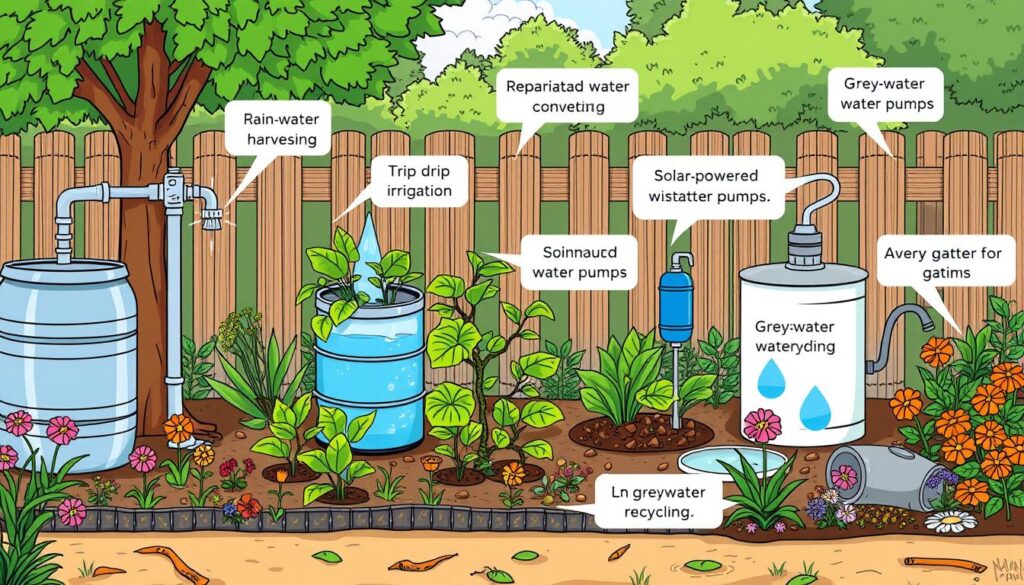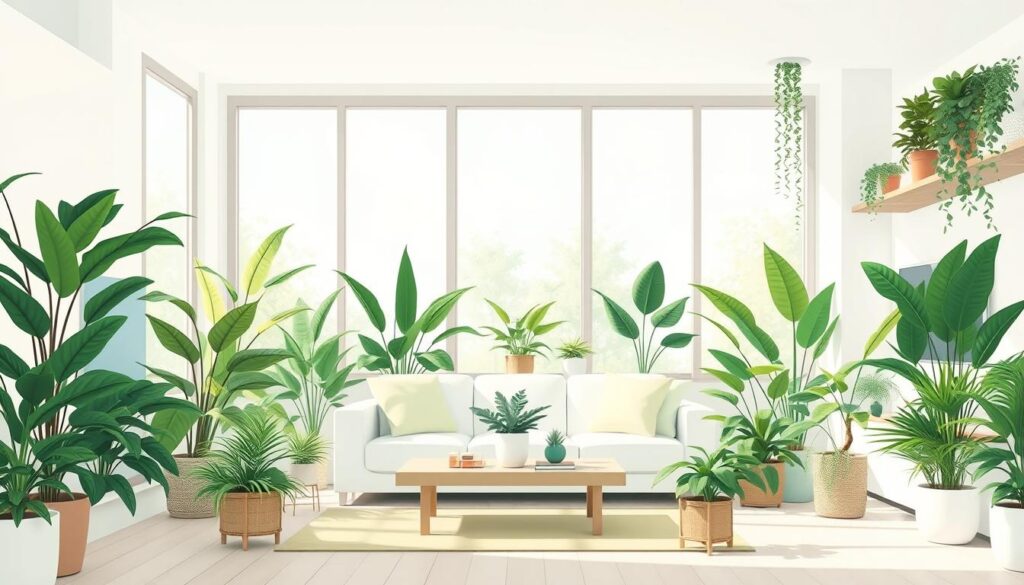Did you know that using energy-efficient appliances and LED lights can help the planet? More and more people want homes that are good for the environment. This is changing how we build and live in houses today.
Sustainable homes use resources wisely and are better for our health. They use solar power and materials that are good for the planet. These homes are not just good for the earth. They also save money and make living healthier.
Key Takeaways
- Sustainable living means making choices that are kind to the planet and reduce waste.
- Eco-friendly homes use less energy and have features that help the environment.
- Smart home tech and new appliances can cut down on bills and use less energy.
- Using materials like bamboo and eco-friendly insulation makes homes better for the planet.
- Homeowners can get help from the government to make their homes more energy-efficient.
Understanding Sustainable Housing: A Modern Necessity
Sustainable housing is now a must, not just a trend. It uses energy-efficient designs to cut down on carbon emissions and save resources. Homes with good insulation, energy-saving windows, and green energy are better for the planet, wallet, and health.
Environmental Impact and Resource Conservation
Sustainable homes aim to lessen their environmental footprint. They use natural light, efficient appliances, and save water. These steps cut down on energy use, emissions, and strain on resources like water and materials.
- Passive solar design uses natural light and heat, reducing the need for energy.
- Energy-saving appliances and LED lights lower bills and emissions.
- Collecting rainwater and using greywater saves municipal water, a valuable resource.
Economic Benefits of Sustainable Living
Sustainable homes save money in the long run. They cut down on utility bills and may qualify for tax breaks. This makes them a smart investment for the future.
- Energy-efficient windows and insulation can cut heating and cooling costs by half.
- Solar panels offer a reliable, affordable power source.
- Water-saving features can greatly reduce water bills.
Health and Well-being Advantages
Sustainable homes are healthier for their residents. They improve air quality, reduce chemical exposure, and create a more comfortable space. This positively affects both physical and mental health.
“Sustainable housing is not just about protecting the environment – it’s about creating healthier, more comfortable living spaces for individuals and families.”
As more people seek sustainable homes, they see the many benefits. These homes are better for the planet, wallet, and health. By choosing sustainable options, we ensure a better future for all.
Smart Home Technology Integration for Sustainability
The future of living sustainably is linked to smart home tech. These systems change how we use resources and energy. They make our homes more efficient and eco-friendly.
Smart thermostats like Nest and Ecobee are big in this area. They learn our temperature likes and adjust it for us. This can cut a home’s energy use by up to 16%, says Lockheed Martin Energy.
Smart tech does more than save energy. IoT devices watch water use and help save it. They also use green materials and solar power, making homes greener.
Smart homes offer more than just energy savings. AI makes homes comfy by setting things up just right. It also keeps appliances running longer and better. This makes life better and helps the planet.
The smart home market is booming, set to hit $338.28 billion by 2030. This tech is key for those wanting a green lifestyle. It could even make the U.S. energy needs smaller by a lot.
“Smart home technology has the power to transform the way we live, work, and interact with our environment, paving the way for a more sustainable and efficient future.”
Eco-Friendly Home Innovations Transforming Modern Living
Today, we celebrate Earth Day’s 53rd anniversary. The focus is on eco-friendly home tech advancements. Designers and builders are now using innovative solutions. These not only cut down on environmental harm but also make our homes better places to live.
Solar Power Solutions
Solar power systems are changing the game for sustainable living. They turn sunlight into clean, renewable electricity. This lets homeowners use less traditional energy, making homes greener and saving money.
Smart Thermostats and Energy Management
Smart thermostats and energy management systems are also making a big difference. They learn how we use energy and adjust it for us. This means we save money and use less energy, helping the planet.
Advanced Water Conservation Systems
Water conservation is key, and new home innovations are leading the way. From low-flow faucets to rainwater systems, these solutions cut down water waste. They help us use water wisely, protecting this vital resource.
| Eco-Friendly Innovation | Key Benefits |
|---|---|
| Solar Power Systems | Clean, renewable energy, reduced reliance on traditional sources |
| Smart Thermostats | Optimized heating and cooling, energy efficiency, cost savings |
| Water Conservation Systems | Reduced water waste, sustainable resource management |
As we focus more on living sustainably, these home innovations are changing how we live. They help us use the sun’s power and save water. This way, we can live comfortably while taking care of our planet.
Revolutionary Building Materials and Design
The construction world is changing fast. It’s moving towards sustainable building materials and green building design. Before, we used natural materials like cob, timber, and straw bales. These are good for the planet and cut down on environmental harm.
These materials don’t need a lot of energy to make. That makes them better for our planet.
Green building also means using the sun’s power. It’s called passive solar design. This way, buildings stay cool in summer and warm in winter without needing a lot of energy.
This method saves a lot of energy and money. The Italian Pavilion at the World Expo showed off new ways to use materials. They used old boats for roofs and recycled stuff for walls and floors.
- The Vertigo Acoustic Wall Panels and Lighting by Feltouch are made from recycled PET bottles. They use 90% less water than regular fabrics.
- The MetaMetal collection by Pure + FreeForm is 100% recyclable. It has lots of recycled content and lasts up to 60 years.
- The Newtro Ceramic Mosaic Tile by Emser Tile lasts 50 to over 100 years. That’s much longer than most tiles.
These examples show how we’re working to make buildings better for the planet. We’re using sustainable building materials and green building design in new ways.
“More than a third of negative environmental impacts are attributed to the construction industry. The shift towards sustainable solutions is crucial for reducing our carbon footprint and preserving our planet.”
Energy-Efficient Appliances and Systems
Using energy-efficient appliances and systems is key to living sustainably. Energy Star certified items use less energy and harm the environment less. For example, smart windows adjust to sunlight and temperature, saving energy.
LED lights also use less energy and last longer than old bulbs. This makes them a smart choice for lighting.
HVAC Optimization Technologies
Modern HVAC systems are crucial for saving energy at home. They use sensors and smart controls to adjust temperature and airflow. This ensures they work well and use less energy.
By improving your HVAC, you can cut down on energy bills. You’ll also reduce your carbon footprint.
Energy Star Certified Equipment
The Energy Star program helps find the most efficient home appliances. It includes smart refrigerators, washing machines, and more. These items are made to work better and use less energy.
“Upgrading to Energy Star certified appliances and HVAC systems can save the average household hundreds of dollars per year on energy bills.”
Choosing energy-efficient home upgrades helps the planet and saves money. Smart windows, LED lights, and better HVAC systems are all good choices. They make your home more comfortable and eco-friendly.
Water Conservation and Management Solutions
The world’s population is growing fast, making clean water a big issue. New tech has brought water conservation and management solutions. These help save water and make our future greener.
Rainwater harvesting is a key solution. It collects rainwater for uses like watering plants and cleaning outside. This cuts down on the need for treated water, saving it for other uses.
Greywater systems are another smart idea. They use water from sinks and washing machines for plants and toilets. This cuts down water use and eases the load on sewage systems.
| Technology | Water Savings | Environmental Benefits |
|---|---|---|
| Rainwater Harvesting | Up to 30% reduction in municipal water use | Reduces stormwater runoff and erosion, recharges groundwater |
| Greywater Recycling | Up to 50% reduction in indoor water use | Decreases wastewater discharge, reduces energy and chemicals required for treatment |
| Smart Irrigation Systems | Up to 30% reduction in water consumption | Optimizes water usage, prevents overwatering, and protects natural habitats |
Smart home technology has changed how we manage water. Smart irrigation systems, for example, use weather and soil sensors to water plants just right. This saves water and helps nature by stopping too much water from running off.
By using water conservation and management solutions, we can protect our water. Homeowners, businesses, and communities all have a part to play in making our future water-secure.
Natural and Sustainable Landscaping Practices
Sustainable landscaping is key to eco-friendly living spaces. It uses natural and drought-resistant methods. This way, homeowners can lower their environmental impact and have beautiful outdoor areas.
Native Plant Selection
Choosing native plants is crucial for sustainable landscaping. These plants fit the local climate and soil, needing less water and care. They can save up to 70% of water, thanks to their deep roots.
Using native plants helps local wildlife and cuts down on water use. It’s a smart choice for a greener home.
Rainwater Harvesting Implementation
Rainwater harvesting fits well with sustainable landscaping. It collects rainwater from roofs and stores it in barrels or cisterns. This way, homeowners use less municipal water.
A 1,000-square-foot roof can catch up to 600 gallons of rainwater in a 1-inch rain. This water is great for irrigation and other outdoor needs.
Drought-Resistant Landscaping
In dry areas, drought-resistant landscaping, or xeriscaping, is a smart choice. It uses plants that don’t need much water and hardscapes that let water through. This cuts down water use by 50-75%.
Xeriscaping makes outdoor spaces look good while saving water. It’s a practical and eco-friendly option.
Sustainable landscaping, like using native plants, harvesting rainwater, and xeriscaping, is a complete approach. It helps conserve water, supports local ecosystems, and makes outdoor spaces beautiful and functional.
Indoor Air Quality Enhancement Technologies
Improving indoor air quality is key to sustainable living. Bad air inside homes can lead to serious health issues. In fact, it’s linked to 3.8 million deaths worldwide each year. Since we spend about 70 years indoors, making our air clean is crucial for our health.
New green home tech is changing how we handle indoor air. Systems like advanced air filters and low-VOC paints help keep air clean. By using smart tech and natural methods, we can make homes healthier and reduce harm to the environment.
- Smart air purifiers and monitors like Amaircare, Foobot, and Awair track indoor air quality factors (PM2.5, VOCs, CO2, humidity) in real-time, providing instant awareness, identifying triggers, optimizing air purifiers, and spotting trends.
- Low-cost monitors for gases, including Carbon Monoxide (CO) and Carbon Dioxide (CO2), offer specific pollutant tracking to improve indoor air quality.
- Safety Siren radon detectors measure radon levels over time, essential for potential mitigation efforts due to radon being the second leading cause of lung cancer.
New air purification tech, like UV-C lighting and HEPA filters, is making air cleaner. These systems help monitor and improve air quality. They also help designs that make air flow better, making homes healthier.
Using materials that don’t release many VOCs and smart ventilation systems are key. These steps help fight ‘sick building syndrome.’ Buildings like The Edge in Amsterdam and the Pixel Building in Australia show how well these techs work.
As people want healthier homes, using air quality tech in green homes will keep growing. It’s a big part of the future of living sustainably.
Zero-Waste Living and Recycling Systems
The world is waking up to the harm our lifestyles cause. Zero-waste living is becoming more popular. It’s about reducing, reusing, and recycling to cut down on trash. This movement uses new composting and waste management tech to change how we handle waste.
Composting Solutions
Composting is key in zero-waste living. It turns organic waste into soil for gardens. The Environmental Protection Agency says composting can cut up to 30% of household waste. Easy composting systems help families live more sustainably.
Smart Waste Management
New tech is making waste management smarter. These systems use data and automation to improve waste collection. They cut emissions and make recycling more efficient. This helps households manage their waste better.
Sustainable Storage Solutions
Living sustainably also means smart storage. Eco-friendly storage helps avoid clutter and promotes simplicity. These solutions make homes cleaner and support zero-waste goals.
Composting, smart waste management, and sustainable storage are key to zero-waste living. They help reduce our environmental impact. They also encourage us to think more about the resources we use.
| Zero-Waste Living Practices | Benefits |
|---|---|
| Composting food scraps | Reduces methane emissions from landfills, creates nutrient-rich soil for gardening |
| Smart waste management technologies | Optimizes waste collection and processing, reduces emissions |
| Sustainable storage solutions | Minimizes clutter, promotes a minimalist lifestyle, reduces waste from excessive consumption |
“Zero-waste living is not just a trend; it’s a necessity for a sustainable future. By embracing innovative solutions, we can reduce our environmental impact and contribute to a cleaner, healthier planet.”
Traditional Techniques Meeting Modern Innovation
We often forget the value of old building ways in our quest for green living. These methods, based on being smart with resources and caring for the planet, help make homes that are good for the earth and fit for today’s needs.
Mixing old building methods with new green tech is a smart way to build homes that are both eco-friendly and modern. Using local, renewable materials and designs that work with the sun, we can make homes that are kinder to the planet. This way, we keep our cultural heritage and learn from the past.
- Old building ways like rammed earth, straw bale, and adobe use materials that are good for the planet and don’t harm it.
- Passive solar design, a key part of old architecture, uses the sun’s warmth and light to keep homes cool without needing lots of energy.
- For generations, people have built homes that work well with their surroundings and use what they have wisely.
By combining these old methods with new green tech, we can make homes that are better for the planet and improve our lives. This mix of old and new is how we can live in homes that are in tune with nature.
| Traditional Techniques | Modern Innovations |
|---|---|
| Rammed earth, straw bale, and adobe construction | Solar power, smart thermostats, and energy-efficient appliances |
| Passive solar design | Advanced water conservation systems and rainwater harvesting |
| Vernacular architecture and site-specific craftsmanship | Smart home automation and IoT-enabled monitoring |
By combining old building ways with new green tech, we can make homes that are better for the planet and improve our lives. This mix of old and new is the way to a more sustainable future.
Conclusion
Eco-friendly home innovations are key to a sustainable future. They offer smart ways to live in harmony with the environment. This includes using energy-saving gadgets, green building materials, and old-fashioned methods.
These innovations help cut down on waste, save money on bills, and make homes healthier. By choosing eco-friendly home innovations, we help the planet and enjoy better living spaces. Sustainable living with green technology lets us make a big difference.
As eco-friendly home innovations keep getting better, they change how we live. They help us build a greener, more aware society. By focusing on sustainable living, we shape a future with homes that are efficient, healthy, and kind to the earth.






